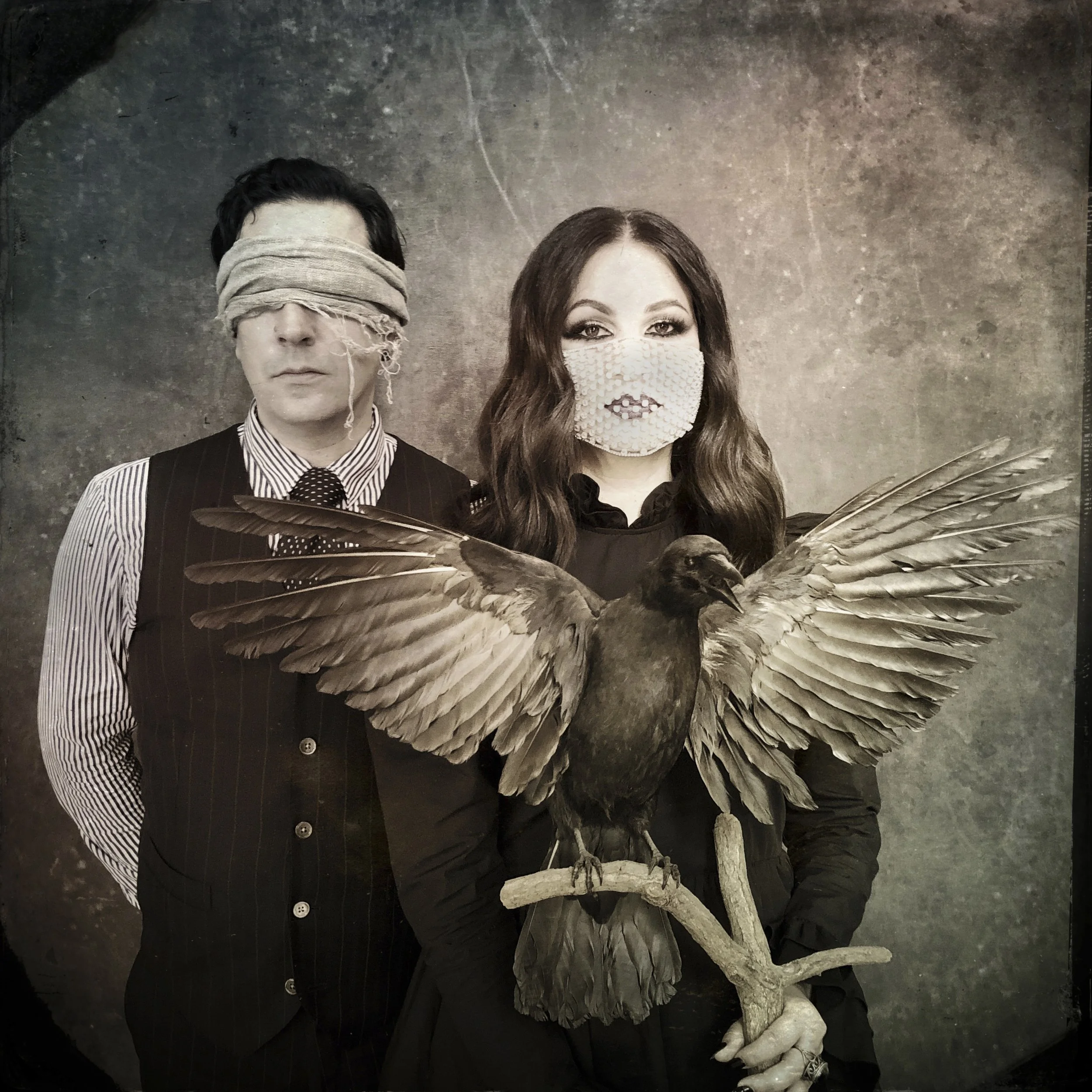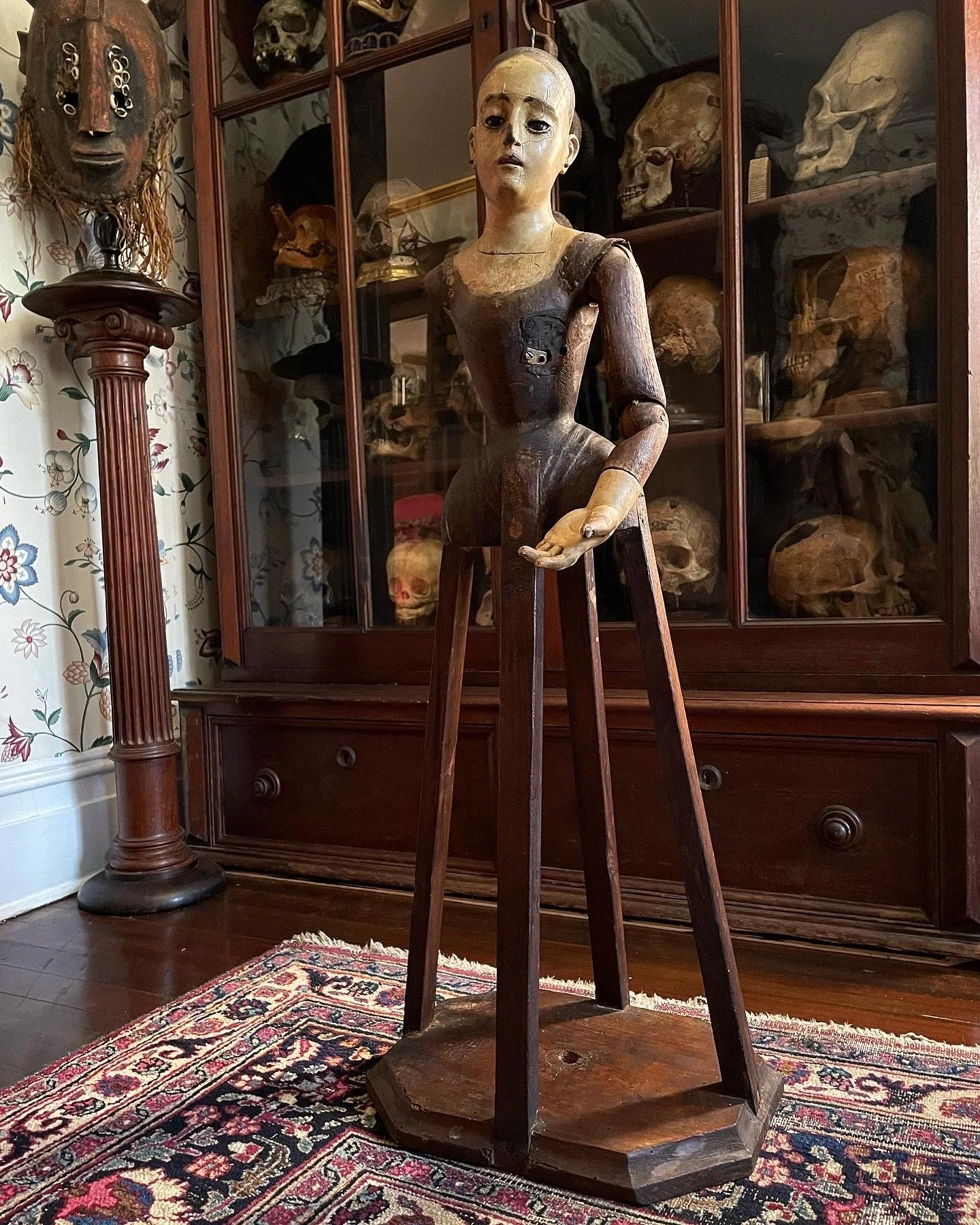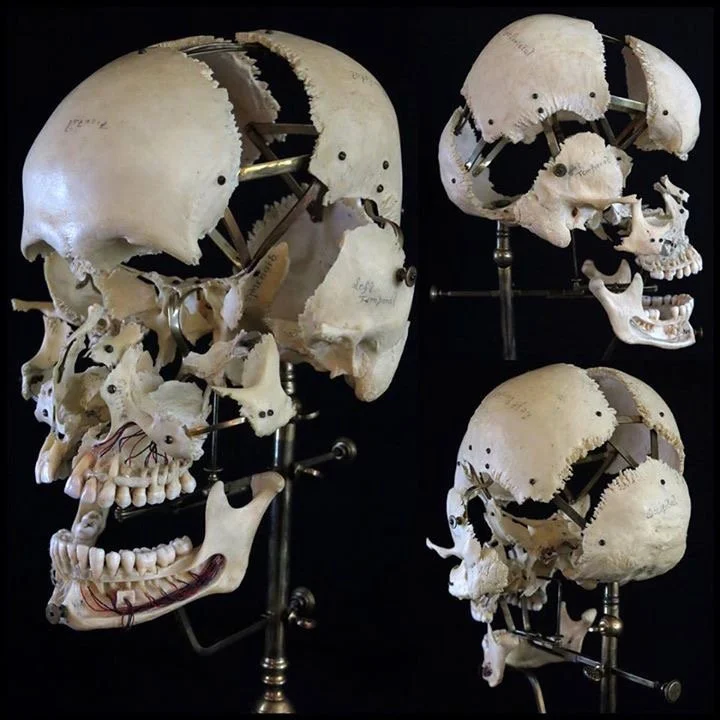A Q&A with Ryan Matthew Cohn, with special guest Regina Marie Cohn! We chat about the Oddities Flea Market and a spooky encounter with a disembodied hand. And, of course, it wouldn’t be an interview with the Cohns without mention of disarticulated skeletons.
A portrait of Ryan Matthew and Regina Marie Cohn that reflects their delightfully warped sensibilites
Duke and I have always been drawn to the bizarre. I mean, we put the Island of Dead Dolls at the top of our CDMX itinerary, and we made sure to hit the Catacombs of Paris. Then there’s the oh-so-creepy Mummy Museum of Guanajuato.
Looking around our place, that fondness for the unusual extends to our décor. A taxidermied monitor lizard. A fertility doll from Cameroon loaded with beads, animal horns and bells. A desiccated chameleon from the witch market in the Marrakech souk. A Javanese puppet head of a little girl in pigtails whose tongue pops out when you pull a string. Duke has decided that our style is “mélange de strahnge.”
Turns out we’re not alone. Ryan Matthew Cohn has made a career out of the growing passion for the weird and the creepy. He was the host of the TV show Oddities and now helps run the Oddities Flea Market with his wife, Regina. –Wally
A glimpse into the Cohn’s oddity-filled Victorian home in Westport, Connecticut
What first got you interested in all things odd?
Ryan: I actually don’t know. I just always have been interested in things that are out of the ordinary. I don’t know if it was a specific event or item necessarily that sparked my interest. But I do know that even when I was very young, I had a huge interest in collecting. And so I think it really started with that. And then as I became a little bit older, my tastes seemed to gravitate towards things that were a little bit more odd in nature. And then, you know, they sort of blossomed into what they are now.
How do you define an oddity?
Ryan: People use this term, sometimes when we’re talking, they say, “Oh, well, that was different.” And I’m always like, “Tell me more. I happen to like things that are different.” So I think in terms of what oddities are like as a genre, it’s anything that’s sort of out the ordinary, curious, or, you know, just strays from the norm.
For a really long time, it was stuff that people didn’t really want. It was stuff that you didn’t really find very often. And certainly a core group of people were collecting that stuff — but it's not anywhere near what it is today.
So oddity collecting has become more popular?
Ryan: Oh, for sure. Oddities is like a household word. Now, back in the day, you just had to hope that you’re gonna find that stuff. And actually, I used to find much more, because there was not much competition. And I think because it’s grown into such a huge subgenre of collecting and lifestyle, it’s made it definitely more challenging to find stuff. But that’s why we started the market.
What prompted you to start the Oddities Flea Market?
Ryan: We felt a strong need to bring a community together that didn’t really have a specific place to go.
Regina: It started as a one-time event in March 2017. And when we couldn’t even get people through the door because the lines were so long, we realized, oh crap, we got to do it again. So we did it again. And then we realized, OK, this is really popular. We’ll bring it back next year. And then we started doing it twice a year. And the following year, I was like, I have a crazy idea: Let’s go to LA.
Finding venues was always the hardest thing for us, because we’re not the type of event that is going to set up in a hotel or a gymnasium. We’re always trying to find the coolest event spaces, and that’s why we don't do a lot of them. We’re definitely more quality over quantity in general. So I don’t see myself doing more than three or four a year. Right now, it looks like New York, LA and Chicago are always going to be on the roster. And then if I can pull off a fourth one, I will.
What’s your vetting process for the market?
Ryan: It’s not necessarily that someone’s not odd enough. It’s curated in a very specific way so that we don't oversaturate what you’ll find in the market. We try not to have too many jewelers, or too many people that work with insects, or too many taxidermists. We try to really keep a very natural flow that makes sense so that when patrons come in there, they have a little bit of everything. We are very selective. It’s a pretty strict process that we go through in terms of deciding who’s going to be at a future market.
You’re dealing with taxidermied animals and sometimes human skulls and the like. Do you ever reject items? What part do ethical or cultural sensibilities play?
Ryan: You have to have a tremendous amount of respect for any of those types of things that you’re dealing with. Of course, with taxidermy, most people claim that they have ethically sourced specimens. So we tend to look for taxidermists that use ethically sourced specimens. Same goes for all of the natural specimens that people use in their artwork and such.
Ryan and Regina’s stunning collection of curiosities includes Spanish santos figures, reliquaries and other ancient artifacts.
What’s the favorite oddity you own?
Ryan: It’s hard to pick one — there’s so many different categories, at least in our collection. Right now, I’m very much into collecting early occult books — books that are from the 14th, 15th and 16th century. And I think those my most coveted items at the moment.
I do collect a lot of saints and reliquaries. Regina and I travel in Europe quite frequently. And every time I go to Europe, I realize that we’re just looking at the literal remains or scraps of what once existed there. It’s very difficult to find the types of things that we collect in America. So, when I go to Europe, I usually fill up a whole suitcase full of paintings and other such things.
So other kinds of collections, I really try to focus my attention on early forms of memento mori: artwork, sculpture and paintings showcasing the skeleton, because my passion started in anatomy.
What oddity of all time do you covet the most?
Ryan: You know, it’s funny — there have been large collections that I didn’t end up getting because maybe they went to auction. I’m one of those people, personally, that if an entire museum is for sale, I want to buy the whole thing. I don’t want one or two pieces. I want everything because then I can kind of figure out what I want with select pieces later: Keep the pieces that make the most sense with our own curations and collection, and then maybe sell some of the other pieces to help fund that collection. I feel like at this point in my collecting career, I have a lot of the pieces that I’ve always sought after.
What do you mean when you say you buy a museum?
Ryan: Say a natural history museum had to shut its doors. I’ll buy the whole thing. Or say a private lifelong collector had been compiling things for his whole life. I’ll get a call and we’ll buy it. I won’t buy two or three items. I'll buy like 3,000.
It’s funny when people are like, “Hey, I have this huge collection. Do you want pictures?” I’m like, “Not really.” I’d rather come there and assess it. Because, you know, you need to be there. You need to be ready to drop money and pounce on a collection. Because if you don’t, or someone’s thought about something for too long, there’s been too much time to think and it’s probably gonna go to auction. The kiss of death.
Have there been any supernatural incidents with your oddities?
Ryan: Both Regina and myself have always been open to the idea of spirits and energies and even actual ghosts in our home. But we’ve actually never really seen anything. We’ve just had a couple strange occurrences like, a doll ending up in another part of the house, but not moved by the dogs.
Regina: One time I was struggling to pull off a zipper. And I turned around, thinking Ryan was helping me — only he wasn’t. He was downstairs. And I found myself making eye contact with a wax hand that was just staring at me.
Ryan: Mind you, the wax hand actually has a glass eye in the middle of it.
I don’t get freaked out about this stuff, personally. If I could get a spirit to manifest itself, I’d probably be a bit wealthier of a human being, cuz I could just charge tickets to come to my house.
Have you ever had any intense reactions from people at the market?
Ryan: Yeah, definitely. A lot of people avoid certain tables. I noticed it’s mostly taxidermy, that people are just so freaked out by it. Or we’ve had people that sort of wandered in from the street and bought a ticket only to go through the market for about two minutes. They are like, what the living hell?! No, that’s not a fake skull.
But for the most part, I think that’s only happened like a handful of times in seven years. Mostly people came to these events because they really wanted to spend time with the vendors and hang out with people.
You two seem to be kindred spirits. How did you meet — and realize you share this affinity for the bizarre?
Ryan: I lived in Brooklyn, and Regina was interested in a skull that I was parting with at the time. It led to meeting up in person because we live close. And, you know, the rest is kind of history. We said, I love you on the third date and basically started working together a year later, doing what we do now.
Regina: Yeah, and I didn’t really know what I was getting into. It was way more intense when I found myself actually entering this world. You know, I came from high fashion luxury. I was working at Agent Provocateur on Madison Avenue. So by day I’m selling lingerie and kimonos; by night I’m learning how to disarticulate a skeleton.
Two years later, I found myself working full time with Ryan. I left my 15-year fashion career to pretty much manage Ryan and then create all these markets.
Ryan: Yeah, Regina is actually the one that started the flea market. I kind of came along for the ride. I think I was more hesitant at the beginning than she was.
The couple collects santos figures like this one-armed articulated 18th century cage doll with glass eyes.
So what’s the best part of your job?
Ryan: The fact that it never really feels like a job. I mean, obviously there are always deadlines. And we are always very busy, considering we have no kids. We never have time to do anything because we always have our hands full with this, that or the other thing. But we truly do care about our community of people. And that’s the best part about it.
Regina: I don’t have to do the market — I do it because I feel like now the vendors rely on me to do it. That’s how they’ve really launched their businesses on another level. So that’s the fun part of what we do, the Oddities Flea Market. There’s just so much more to our daily life — like we’re writing a book right now.
I was going to ask about your future plans. Tell me about this book.
Ryan: The book I think is gonna probably launch in late 2024. We’re working with Chronicle. It’s going in the direction of telling the tale of what purchasing collections is like, our two different points of views. And then what we did with the collection.
There are other interesting adventures that we’ve been on. Because when you’re doing this stuff all the time, you sort of take it for granted. You go, oh, yeah, we just bought a museum. And yeah, that’s really fun. But we do it so frequently that it almost doesn’t seem terribly interesting after a while. But when we tell the story, people are always intrigued and have a lot of questions. And I think the book came as a result of that.
What about your art, Ryan?
Ryan: I actually have a gallery show coming up in November in Seattle at Roq La Rue Gallery.
Because we travel so frequently, we tend to be pretty busy. I don’t get to work on my art as frequently as I used to. But I do try to be selective. I usually feature a piece or two a year in a show.
Most of the work that I do these days is based on antiques. So for instance, at this upcoming show, I’m working with 18th century saint statues that I’m articulating. And so they’re sort of a mixture of the earlier pieces that I did with osteological specimens but using antique wood, genuine pieces that were purchased from Italy and other places that I traveled to.
One of Ryan's Beauchêne exploded skulls
I know you’ve worked with skulls and broken them apart.
That’s something that I still do on occasion. But like I said, I’m very selective at this point in my career. I do as much of that stuff as I can. But it gets very, very time consuming and requires a ton of patience.

























